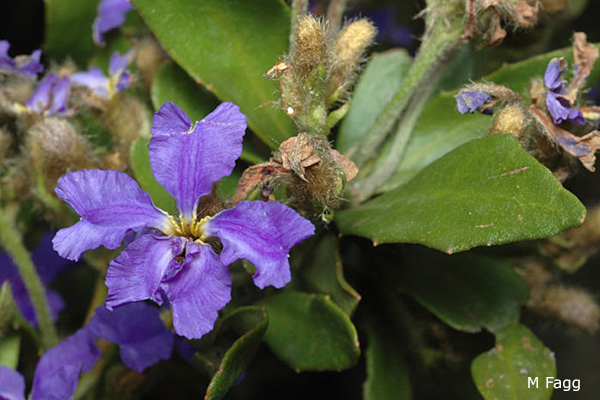General Description:
Dampiera is a genus of 60-70 species, all of which occur only in Australia. They are generally small herbs or shrubs having blue to purple flowers with a yellow centre. Only a few species are seen in cultivation, the most widely available being D.diversifolia, a Western Australian species which has become well established in the nursery trade.
Dampiera sylvestris is a small, herbaceous plant which spreads by suckering. It usually grows up to 200 mm high, but can be taller if among dense understorey of other plants and grasses. Leaves are up to 3 cm long, with some toothing on the margins, and sparsely along slightly angled stems. Occurring in spring, the fan-like flowers can be either brilliant cobalt-blue, or a lighter powder-blue. They occur singly or a few at ends of the stems.
At the Marcoola development area (south of Coolum Beach, Sunshine Coast, Queensland), plants were ‘rescued’ from what was very wet heath with peaty grey soil. Here the flowers are usually the deeper blue, the paler colour being more often found in forest understorey. A similar species, D.stricta, has been confused with D.sylvestris. The Queensland Herbarium confirms that D.sylvestris is found along the coastal strip, with D.stricta occurring on sandstone areas further inland, to the south of Brisbane at Plunkett, and in the Stanthorpe/Girraween region.
Not widely cultivated except by wildflower enthusiasts, D.sylvestris probably has potential as a “filler” plant in a wildflower garden. Long term hardiness is unknown, but it gives a good contrast to the many yellow and white flowers in woodland Wallum, and adds to the charm of a small posy of mixed wildflowers. In nature, it seems to grow best in sandy coastal soils. It grows in the wet Wallum heaths, on the drier deep sand dunes (not frontal), and the understorey of the open eucalypt (mostly Eucalyptus racemosa – scribbly gum) forests. These can be adjacent to Wallum wetlands or on hinterland ranges, but always sandy soils. It takes longer to establish in light gravelly soils but it will then quietly sucker among other plants.
Propagation from seed is unreliable but cuttings taken from the suckering stems should strike readily.

Dampiera sylvestris
Photo: Murray Fagg – Australian National Botanic Gardens
 Australian Native Plants Society (Australia)
Australian Native Plants Society (Australia)